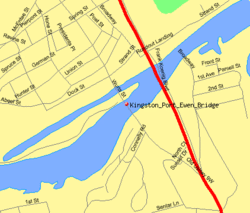Kingston-Port Ewen Suspension Bridge
| Kingston–Port Ewen Suspension Bridge | |
|---|---|

Bridge looking north into Kingston, 2007.
|
|
| Coordinates | 41°55′02″N 73°59′03″W / 41.91716°N 73.984165°WCoordinates: 41°55′02″N 73°59′03″W / 41.91716°N 73.984165°W |
| Carries | Wurts St. (Old |
| Crosses | Rondout Creek |
| Locale | Kingston, New York |
| Official name | Kingston–Port Ewen Suspension Bridge |
| Maintained by | New York State Department of Transportation |
| ID number | 1007350 |
| Characteristics | |
| Design | Wire cable Suspension bridge |
| Total length | 2 side spans of 176.25 feet (54 m) each, anchorages, total length 1,145 ft (349 m) |
| Width | 2 lanes plus walkway, 37 feet (11 m) |
| Longest span | 705 feet (215 m) |
| Clearance below | 85 ft (26 m) |
| History | |
| Opened | 1921 |
| Closed | still open but reportedly limited to 3 tons (2.5 tonnes) |
| Statistics | |
| Daily traffic | 15,700 |
| Toll | no |

TIGER image, Red dot marks bridge
|
|
The Kingston–Port Ewen Suspension Bridge, sometimes known as the "Rondout Creek bridge", "Old Bridge" or "Wurts Street Bridge", is a steel suspension bridge spanning Rondout Creek, near where it empties into the Hudson River. It connects the City of Kingston to the north, with the village of Port Ewen to the south. Completed in 1921, it was the final link in New York's first north-south highway on the West Shore of the Hudson, and is considered an important engineering accomplishment associated with the development of early motoring.
Construction began in 1916, with a view to replacing the Rondout Creek ferry Skillypot, known for sporadic service. The bridge was designed by the firms of Holton D. Robinson and John A. Roebling's Sons Company, with Holton D. Robinson, Daniel E. Moran, William Yates listed as chief engineers Construction was hampered by local political and financial difficulties, as well as material shortages caused by entry by the United States into World War I, and was suspended until 1920.
When construction resumed, David B. Steinman was among the engineering staff, acting as Assistant Engineer. Completion took about a year, and local legend has it that the contractors employed a woman as a welder: commonplace during World War II, but unheard of in 1920. Ten thousand people attended the bridge's dedication on November 2, 1921. The bridge has a very hilly approach on the north side and crosses a small island in the creek. It forms a dramatic backdrop to the Rondout-West Strand Historic District to the east.
Although the bridge was a key U.S. Route 9W link when it opened, carrying 9W and Wurts Street, in 1978 9W was rerouted to the John T. Loughran Bridge. 9W at that point is also called Frank Koenig boulevard. The weight limit on the bridge was down to 5 tons, as of 2015 it has been further reduced to 3 tons.
According to the U.S. Department of Transportation (“DOT”), one of every eight bridges in the nation is structurally deficient; among the most deficient is the Kingston–Port Ewen Suspension Bridge. The bridge rates consistently low in state and federal dot evaluations. It is rated as a 2 out of 100 from the federal DOT and a 3.875 out of 7 from the state. Both evaluations take away points for obsolete design, which is not really a concern since looking charmingly obsolete may be its only real function since a newer, larger bridge with wider, straighter approaches was installed less than 1/4 mile from this one. The new bridge is less ornate though perhaps more functional, but has the effect of splitting the downtown area and was made possible only by the demolition of half of the downtown Rondout, New York historic district. The old bridge is considered structurally deficient by both agencies and for that reason it is limited to carrying vehicles of 5 tons or less. According to a structures engineer for the state DOT, an inspection of the main cables will be carried out in the spring of 2008 by the engineering firm of Modjeski & Masters which specializes in signature (unusual) & suspension bridges. A complete renovation including replacement of roadbed but not including replacement of main cables was planned for 2009. That renovation had not been started as of January 2012. In 2004 the Federal Highway Administration estimated the reconstruction cost at 3 million dollars. The original cost of the bridge was $700,000 in 1921 - which is the equivalent of eight million dollars in 2007 according to the Bureau of Labor Statistics.
...
Wikipedia
